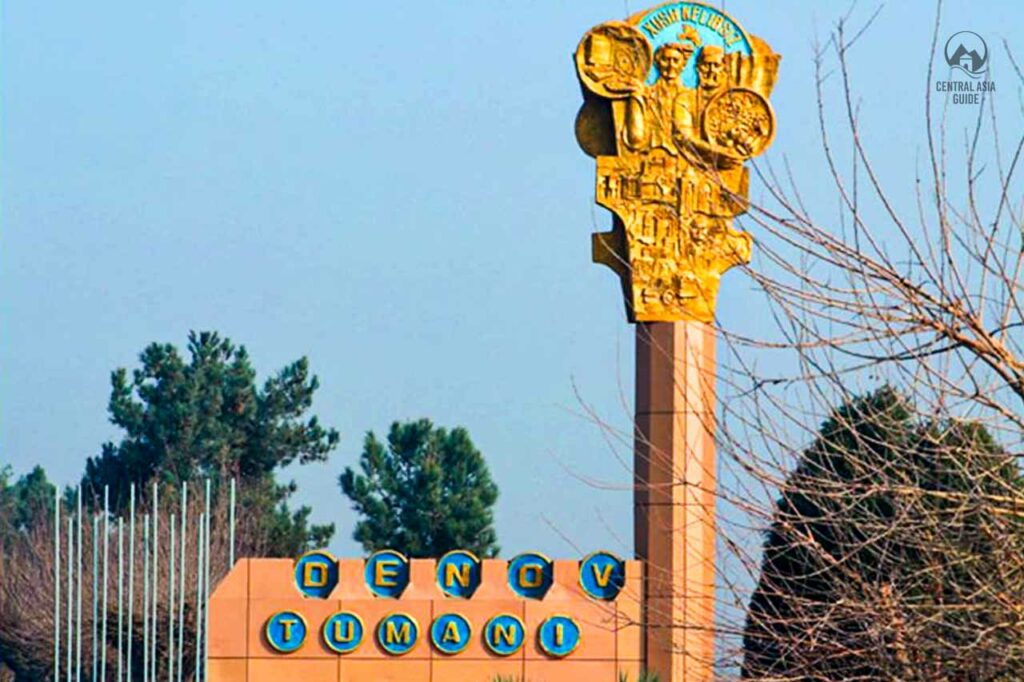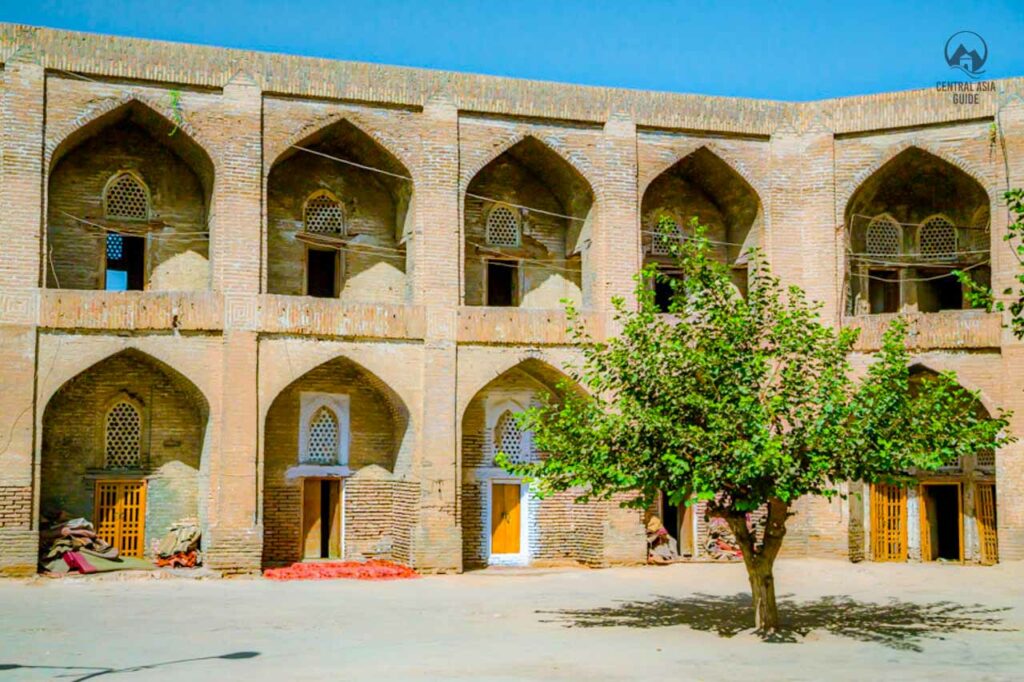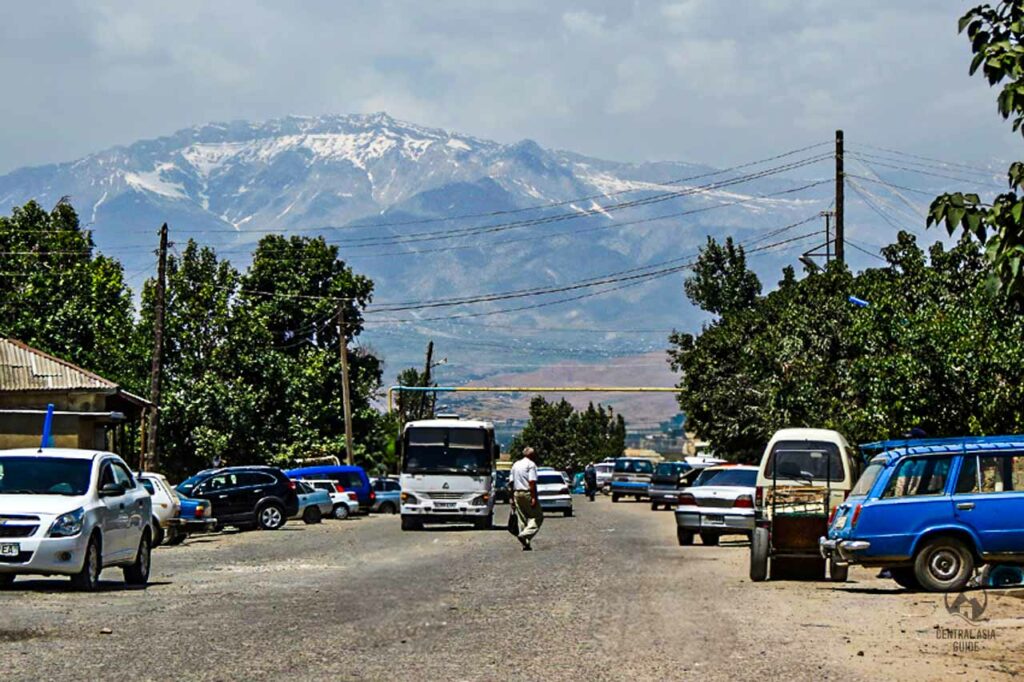Denau
Denov Town
Denau, also known as Denov, is a town located in the Surkhandarya region of Uzbekistan, serving as the administrative center of the Denau district. It is strategically positioned near the Tajikistan border, making it an important gateway between Uzbekistan and Tajikistan. The town sits along the Sukhandarya River, which historically formed part of the ancient trade routes leading to Dushanbe, the capital of Tajikistan.
Denau is a small but bustling town, framed by the stunning Hissar Mountains to the north and the Chulbair Range to the west. Its proximity to the border with Tajikistan and its location on key trade routes has made it a place of historical importance. Denau was once a stronghold of the Gissar/Hissar Khanate, and the town was later named after Denau Beg, the Emir of Bukhara. Additionally, the name “Denau” translates to “new village” in Tajik, reflecting its relatively recent development. Today, Denau is home to over 130,000 people.
Denau is also well-known for its wine. As the heart of Uzbekistan’s winemaking industry, the region is dotted with vineyards, a legacy of the Soviet-era winery that was once one of the largest in the country. Interestingly, Denau was also the only town in the Soviet Union that produced rum. The Gissar Mountain range provides a stunning backdrop to the town, with its highest peak, often referred to as Hazret-Sultan, though some debate if this is the true highest point. Some believe a different peak holds that title, leaving the highest unnamed.


History of Denov town
Though the town of Denau is less than 70 years old, its history goes further back in time. It was once part of the ancient city-state of Chaganian, which existed between the 6th and 11th centuries. Denov, located on the site of an ancient trade and craft settlement, holds a rich and storied past. Believed to have been a significant urban area as early as the late second millennium BC, Denov has served as a hub of commerce, culture, and craftsmanship for centuries.
Local legends describe Denau as a place that was once flourishing with wealth and prosperity. Even today, remains of the medieval fortress and evidence of ancient architecture tell stories about its glory.
Early History and Chagonion
According to historical sources like Mahmud ibn Wali in the 17th century, Denov, or “Dehinav,” referred to a fortified fortress with a grand bazaar, a prominent mosque, and rooms for travelers. Some researchers have speculated that the ancient city of Chagonion occupied the same site as present-day Denov. Archaeological evidence suggests that the city of Chagonion corresponds to the Budroch settlement (Budrochtepa), located 6 kilometers southeast of modern Denov. The area was densely populated during the late antiquity and early Middle Ages, flourishing as a key urban settlement.
Mongol Conquest and Timurid Revival
Following the Mongol invasion, the prominence of Chagonion-Budroch began to wane in the 15th and 16th centuries. However, under the Timurids, the region regained significance, with Denov emerging as one of the main centers of the time. The Denov Fortress, dating back to the 15th century, is a remarkable example of the city’s historical architecture. The fortress, a complex monument with surrounding trenches, features a thick defensive wall and spans a diameter of 110 meters.
Denov in the Bukhara Khanate
In the 17th and 18th centuries, Denov became an independent governorate within the Bukhara Khanate. It flourished as a center of caravan trade, facilitating commerce along vital trade routes. The city boasted over 100 craft workshops specializing in leather making, shoemaking, weaving, jewelry, confectionery, and toy making, underscoring its importance as a craft and trade hub.
Modern Developments
In the early 20th century, Denov witnessed significant events, including a popular uprising in 1907 against the Amir’s tax policies. By 1920, the town was incorporated as a city. The construction of the Termez-Dushanbe road in 1925 further cemented Denov’s role as a key connection between Uzbekistan and neighboring regions.
Today, Denov’s rich historical tapestry is reflected in its landmarks, including the remnants of its fortress and the enduring legacy of its vibrant trade and craftsmanship traditions.


What to Do in Denau
Althought Denau is not be a major tourist destination, but it offers several attractions for those passing through. The region around Denau enjoys a subtropical climate, which has fostered the growth of a local wine industry. The area is known for producing quality wines from grape varieties such as “Novbakhor,” “Morastel,” and “Uzbekistan,” which are appreciated for their distinct flavors. Additionally, Denau is famous for producing rum from sugarcane grown in local plantations.
Denau Bazaar
One of the key highlights of the town is the Denau Bazar, a lively and large market where visitors can experience local culture, shop for fresh produce, and explore a variety of traditional goods. The town’s historical significance, combined with its pleasant climate and bustling market, makes Denau an interesting stop for travelers in the region.
Denau bazaar is the largest in the whole Surkhandarya region, merchants from nearby mountain villages and even from Tajikistan come here to trade. It is a colorful and dynamic bazaar, filled by cross-border trade with Tajikistan. Here one cal also find the Denau region ceramics and toys, which are famous for the Zukhurov masters.

Said Atalyk Madrasah: A Historic Gem in Denau
Located in the heart of Denau’s bustling main bazaar, the Said Atalyk Madrasah is a significant historical and architectural monument dating back to the 16th century. Despite its lack of intricate ornamentation, the structure impresses with its grand scale and elegant symmetry, making it a standout example of Islamic architecture in the region.
The madrassa has experienced several closures over its long history. It was shut down in 1935 during Soviet times, reopened following Uzbekistan’s independence in 1991, and closed again in 1997 for renovations. Today, the madrassa remains a symbol of Denau’s rich cultural heritage, offering a glimpse into the area’s storied past.
Denau Arboretum: A Botanical Treasure in the Heart of the Town
Situated near the center of Denau, the Denau Arboretum, named after R. Shreder, is a lush haven showcasing over 1,000 species of trees, flowers, herbs, and plants from diverse cultures across the globe. Its collection includes rare and exotic specimens such as rubber trees, bamboo, sequoias, and 200 varieties of persimmon, alongside an array of other unique flora.
The arboretum’s extraordinary diversity is largely thanks to contributions from visiting dignitaries and scientists from around the world, making it not only a botanical marvel but also a testament to international collaboration. It offers visitors a serene and educational stroll through a unique blend of natural beauty and scientific heritage.
Ancient Settlements Near Denau
The region surrounding Denau is home to several fascinating ancient sites that offer a glimpse into the area’s rich history. The Surkhan River Valley, encompassing Denau and the ancient city of Chaganian, was a significant cradle of Kushan urbanization. These ancient settlements highlight the region’s importance as a cultural and economic hub during the Kushan era, making it a must-visit for history enthusiasts exploring Uzbekistan.
Kulchayan Ancient City: A Glimpse into Graeco-Bactrian History
Located approximately 10 kilometers northeast of Denau, Kulchayan is an ancient city dating back to the 4th century BC, making it one of the earliest settlements in the region. Once a thriving Graeco-Bactrian city, Kulchayan played a significant role in the area’s early history.
Excavated in the mid-20th century by Soviet archaeologists, the site revealed a wealth of Kushan-era sculptures. These artifacts vividly depict the hairstyles, clothing, and ethnic characteristics of Kulchayan’s ancient inhabitants, offering valuable insights into the cultural and social life of the time.
While the site itself is accessible by car, many of the best discoveries are housed in the Termez Archaeological Museum and the Fine Art Museum in Tashkent, making these institutions essential stops for those interested in exploring Kulchayan’s legacy.
Dalverzintepa Ancient City: A Glorious Relic of Kushan Civilization
Dalverzintepa, also known as Dalvarzin Tepe, is a remarkably preserved ancient settlement located approximately 20 km south of Denau and 60 km north of Termez in the fertile Surkhandarya River Valley. Spanning about 47 hectares, this site was a prominent center of the Kushan Empire and served as an early capital for the Tokharian (Yue Chi) Turkic tribes.
Getting Around in Denau
Denov has its railway station, which is of great importance for the city’s connection with the region. Denov is located 156 kilometers away from Termez. The railway was laid in 1929 and played a great role in the development of the city, being the impulse for the manufacturing industry.
Denau is perfectly connected with other cities in Uzbekistan mainly throught the railway as well as by road. Most visitors from Tajikistan usually traveling by shared taxi or minibus along the picturesque road through the hills to Samarkand (5hrs), Bukhara (6hrs) or Termez (2hrs).
There are regular public busses, minibus and shared taxis operated to the big cities. You can take transportation from the new bus station on Makhtumkuli, close to the bazaar. There are also daily buses to Baisun and Tashkent. However, at the present time for the Dushanbe bus run only to the border, from where onward buses can be caught inside Tajikistan.
Sights and destinations near Denau
Page updated 30.12.2020